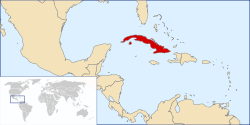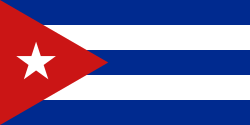

The following outline is provided as an overview of and topical guide to Cuba:
Contents
- General reference
- Geography of Cuba
- Environment of Cuba
- Regions of Cuba
- Demography of Cuba
- History of Cuba
- By period
- By region
- By subject
- Government and politics of Cuba
- Branches of the government of Cuba
- Foreign relations of Cuba
- Law and order in Cuba
- Military of Cuba
- Local government in Cuba
- Culture of Cuba
- Art in Cuba
- Religion in Cuba
- Sports in Cuba
- Economy and infrastructure of Cuba
- Communications in Cuba
- Transportation in Cuba
- Education in Cuba
- Health in Cuba
- See also
- References
- External links
Cuba – island country in the Caribbean. It consists of the main island of Cuba, the Isla de la Juventud, and several archipelagos. Havana is the largest city in Cuba and the country's capital. Santiago de Cuba is the second largest city. [1] [2] Cuba is home to over 11 million people and is the most populous island nation in the Caribbean. Its people, culture, and customs draw from diverse sources, such as the aboriginal Taíno and Ciboney peoples, the period of Spanish colonialism, the introduction of African slaves and its proximity to the United States.




